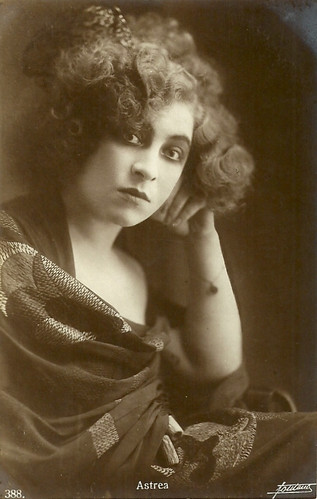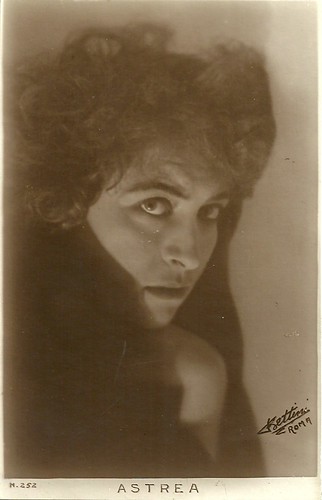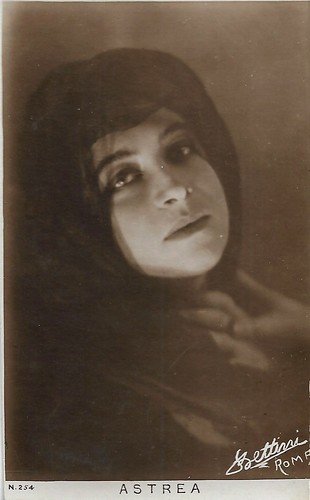
Italian postcard, no. 388. Photo: Fontana.
Goddess of innocence and purity
Next to the various 'forzuti' or strongmen of Italian cinema of the late 1910s, there were a few female versions, 'forzuta'. Most of these strong women have remained unknown till recently, e.g. Linda Albertini, Ethel Joyce, Gisa-Liana Doria and Piera Bouvier. Of the Italian women who performed athletic roles in films, perhaps the most prominent is the mysterious Astrea.
Thanks to a print at the Milanese film archive of the film Justitia, Astrea WAS known, though her biography has remained as misty as the London fog.
Nothing is known about her dates of birth and death, nor her original name. Was she a Venetian countess or did she come from the circus? Silents, Please!: "Astrea is usually mentioned to be the pseudonym of a Venetian noblewoman, contessa Barbieri or ‘contessa B’. In his article on athletic women in silent cinema, David Chapman mentions that an expert on the history of Venetian film has studied the matter and is certain that her family name is Barbieri. [...] However, no further personal details are yet known about Astrea/Barbieri."
The film actress Astrea was a sturdy and sportive female athlete, defender of the weak and fighter of crime, helped by her comical sidekick Polidor (Ferdinando Guillaume). Astrea’s name refers to Astrea (or Astraea), the virgin goddess of innocence and purity in Greek mythology, who in the so-called Iron Age left Earth as it had become too criminal and debauched. There is also a connotation of stardom or diva status to the name.
Astrea was billed as an "emula" (female imitator) of Maciste, and while attractive, she was also extremely tall and gave the impression of a muscular solidity. In her short career Astrea only made four films, all within the athletic-acrobatic genre of Italian silent film, but here combining it with comedy too.

Italian postcard, no. 252. Photo: Bettini, Roma.

Italian postcard, no. 254. Photo: Bettini, Roma.
Astrea first acted in a rather heavy anti-Austrian propaganda film, La riscossa delle maschere/The Masks' Counterattack (Leopoldo Carlucci, 1919), though IMDb writes the director was Gustavo Zaremba de Jaracewski, co-starring Gian Paolo Rosmino. In the film, all Italian 'masks' (the characters from the Commedia dell’Arte, used as symbolic representations of different regions of Italy) are reanimated by Astrea to rescue the Italians from the Austrians. Astrea behaves like a real killer, drowning spies, and feeding her enemies bit by bit to the pigs, with violence and sadism unknown to her male competitors, mostly good-hearted giants. The film was made after the defeat at Caporetto and was supposed to boost morale, but because of censorship problems, it was only released after the war ended.

Italian postcard, no. 389. Photo: Fontana.
Sources: Silents, Please!, Alberto Farassino/Tatti Sanguineti (Gli uomini forti - Italian), Michele Giordano (Giganti buoni - Italian), Topics in Italian Cinema: the Peplum and IMDb.
This post was last updated on 24 April 2023.
The film actress Astrea was a sturdy and sportive female athlete, defender of the weak and fighter of crime, helped by her comical sidekick Polidor (Ferdinando Guillaume). Astrea’s name refers to Astrea (or Astraea), the virgin goddess of innocence and purity in Greek mythology, who in the so-called Iron Age left Earth as it had become too criminal and debauched. There is also a connotation of stardom or diva status to the name.
Astrea was billed as an "emula" (female imitator) of Maciste, and while attractive, she was also extremely tall and gave the impression of a muscular solidity. In her short career Astrea only made four films, all within the athletic-acrobatic genre of Italian silent film, but here combining it with comedy too.

Italian postcard, no. 252. Photo: Bettini, Roma.

Italian postcard, no. 254. Photo: Bettini, Roma.
Feeding her enemies bit by bit to the pigs
Astrea first acted in a rather heavy anti-Austrian propaganda film, La riscossa delle maschere/The Masks' Counterattack (Leopoldo Carlucci, 1919), though IMDb writes the director was Gustavo Zaremba de Jaracewski, co-starring Gian Paolo Rosmino. In the film, all Italian 'masks' (the characters from the Commedia dell’Arte, used as symbolic representations of different regions of Italy) are reanimated by Astrea to rescue the Italians from the Austrians. Astrea behaves like a real killer, drowning spies, and feeding her enemies bit by bit to the pigs, with violence and sadism unknown to her male competitors, mostly good-hearted giants. The film was made after the defeat at Caporetto and was supposed to boost morale, but because of censorship problems, it was only released after the war ended.
It was Astrea’s next film that was to make her name. In the action-comedy Justitia/Astrea, the Amazing Woman (Polidor, 1920) the tone was much milder. The film was directed by French comedian Ferdinando Guillaume a.k.a. Polidor, while Astrea, Guillaume’s relatives and he himself acted in the film. Astrea plays the double role of a well-groomed and dressed princess, who is cliché-like also a retributive yet also a big-hearted avenger, who protects a lovers’ couple hunted by the usual bad guys.
With actor-director Ferdinando Guillaume, Astrea did two more films, L’ultima fiaba/The last fairy tale (Polidor, 1920) and I creatori dell’impossibile/The creators of the impossible (Polidor, 1922). Vittorio Martinelli wrote that the latter was a rather far-fetched farce, ‘so Countess B. retreated to the shadows, silently, leaving her crown of the queen of muscles, not permitting anybody to touch her privacy’. For decades, both films were presumed to be lost.
Film magazine La rivista cinematografica noted: "Astrea is … Astrea, strong, daring and agile, an athlete of the first order and an elegant lady at the same time." While the Italian press praised her as athletic and lady-like at the same time, the British journal The Bioscope called her ‘a herculean woman with the defiance of a Houdini, a female knight roaming the world to set wrong situations right with the force of her muscles.' Anyway, Justitia had a wide international distribution and was a big success, partly under the title 'Astrea'.
With actor-director Ferdinando Guillaume, Astrea did two more films, L’ultima fiaba/The last fairy tale (Polidor, 1920) and I creatori dell’impossibile/The creators of the impossible (Polidor, 1922). Vittorio Martinelli wrote that the latter was a rather far-fetched farce, ‘so Countess B. retreated to the shadows, silently, leaving her crown of the queen of muscles, not permitting anybody to touch her privacy’. For decades, both films were presumed to be lost.
In 2010, a French print titled 'Astrea' was shown at the Il Cinema Ritrovato festival as part of the programme 'Astrea e altre stelle atletiche' (Astrea and other athletic female stars). Monica Dall’Asta wrote in the festival catalogue: “The French copy found in the French Archives bears the simple title Astrea, but the plot does not correspond to Justizia, the first production of the Astrea-Polidor duo, distributed internationally with great success under the title Astrea; our identification of this film as L’ultima fiaba is still a working hypothesis.”

Italian postcard, no. 389. Photo: Fontana.
Sources: Silents, Please!, Alberto Farassino/Tatti Sanguineti (Gli uomini forti - Italian), Michele Giordano (Giganti buoni - Italian), Topics in Italian Cinema: the Peplum and IMDb.
This post was last updated on 24 April 2023.
No comments:
Post a Comment